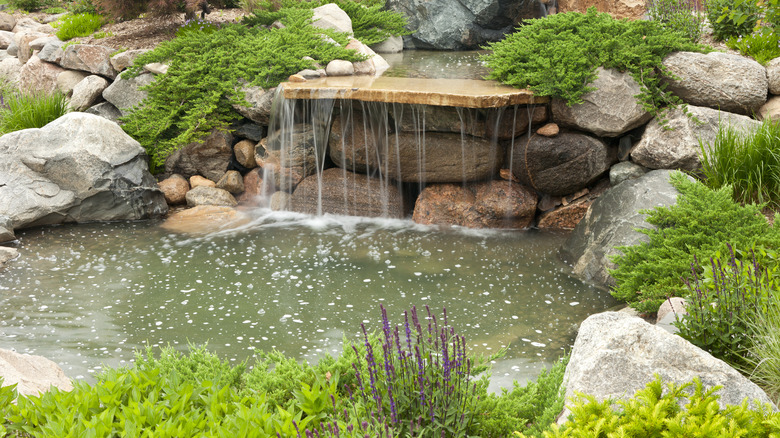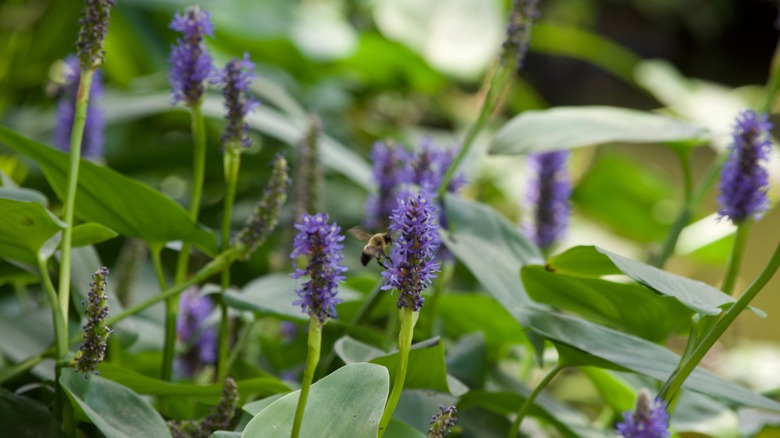Attract This Beneficial Insect To Your Yard To Help Keep Mosquitoes Away
Nothing ruins an evening out on your patio faster than a swarm of mosquitoes. Rather than enjoying the ambiance, you're busy swatting away pests that are trying to eat you alive. While lighting citronella candles and investing in mosquito repellent plants can help, there is yet another tactic you can add to your battle plan: attracting dragonflies. Mosquitoes are a part of their everyday diet, and dragonflies often snack on them mid-flight. In fact, their nickname is "mosquito hawk" for this very reason. Because of this, they can help keep the pest population in your backyard in check. However, keep in mind this isn't a miracle cure. While they will help keep the amount of mosquitoes down, they likely won't fully eradicate them. So make them a part of your mosquito-control plan and not the sole strategy.
Certain things can be done to attract dragonflies to your yard. They love water, so you can install a pond in your garden. They are also attracted to certain plants, so you can include a variety of them in your landscaping to lure them in. If you invest in these two things, your yard will seem very hospitable to dragonflies and will have them coming back again and again. Here is how to attract dragonflies to your yard to keep mosquitoes at bay.
Add a pond to attract dragonflies
Since dragonflies are aquatic, you need a body of water in your yard in order to attract them. They spend most of their life cycle submerged — the eggs are laid in water, and when they hatch, the young dragonflies (or naiads) stay underwater until they become adults. Because of this, you need a body of water in your yard for them to come buzzing around. A pond is best since they won't be able to comfortably lay their eggs in the shallow waters of things like bird baths. However, the pond should be several feet deep and filled with underwater and floating aquatic plants, which provide shelter for eggs and naiads and a place to perch for dragonflies. A simple, fiberglass or plastic-lined pond will be too shallow and small to properly attract these insects, so make sure to create something larger. Ring the pond with flat stones and plant protruding sticks inside the waters, both of which give a place for dragonflies to land.
While ponds attract dragonflies, they also attract mosquitoes, which could intensify your problem. However, mosquitoes are mostly attracted to shallow, still water. Because of this, ensure your pond is deeper than 2 feet to discourage them from buzzing around and laying their eggs in the water. Mosquitoes also need still water to breed, so adding a moving water feature to the pond, such as a fountain, waterfall, or aerator, will also discourage them.
Cultivate dragonfly-friendly plants
Certain plants will attract dazzling dragonflies to your garden. However, since dragonflies are carnivores, they won't be visiting flowers to collect nectar or pollen. Instead, focus on planting native plants that provide shelter, attract the kind of bugs they like to eat, and are commonly found around ponds, swamps, and other bodies of water. If you have a pond in your yard, then there are certain plants you'll want to keep in it. Planting pickerelweed and wild celery is a great first step. Pickerelweed grows in or around streams and ponds and has tall, stalky flowers that are perfect for dragonflies to perch on. Plus, they like to lay their eggs on the stems, so it will be sure to attract them. Wild celery grows underwater and is perfect for ponds that are at least 2 feet deep. They're another great place for egg laying.
Dragonflies also love to perch near the water, so planting tall, swaying flowers around a water feature or pond will help these jeweled insects land in your yard. Joe-Pye weed attracts pollinators, which dragonflies see as tasty meals, and can grow anywhere from 3-12 feet, which is great for them to relax on. Meadow sage and swamp milkweed are also great contenders for the same reasons. Meadow sage can grow up to 3 feet tall, and swamp milkweed can sprout up to 5 feet high.


